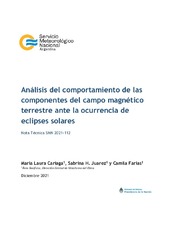Análisis del comportamiento de las componentes del campo magnético terrestre ante la ocurrencia de eclipses solares
Autores

Resumen
El Servicio Meteorológico Nacional (SMN) obtiene mediciones del Campo Magnético Terrestre (CMT) desde hace más de un siglo, mediante la operación ininterrumpida desde 1903 del Observatorio Orcadas del Sur en la Antártida Argentina. En la actualidad el Área de Geofísica de este Organismo tiene la coordinación de la operación de los observatorios, obtención de datos y el análisis de estos.
El objetivo de este estudio es analizar el comportamiento de los potenciales efectos en las componentes del Campo Magnético Terrestre (CMT) ante la ocurrencia de los eclipses solares totales ocurridos el 2 de julio de 2019 y 14 de diciembre de 2020, utilizando las mediciones obtenidas en la red de observación geomagnética del Servicio Meteorológico Nacional.
The National Meteorological Service (SMN) has obtained measurements of the Earth's Magnetic Field (CMT) for more than a century, through the uninterrupted operation since 1903 of the South Orcadas Observatory in the Argentine Antarctic. At present, the Geophysics Area of this Organization has the coordination of the operation of the observatories, data collection and analysis.
The objective of this publication is to analyze the behavior of the potential effects on the components of the CMT in the event of total solar eclipses that occurred on July 2, 2019 and December 14, 2020 using the measurements obtained in the geomagnetic observation network of the National Meteorological Service.
Cita
Colecciones
- Notas técnicas [175]
Fecha
2021-12Metadatos
Mostrar el registro completo del ítemUtilice este identificador (URI) para citar o enlazar este item
http://hdl.handle.net/20.500.12160/1754El ítem tiene asociados los siguientes ficheros de licencia: